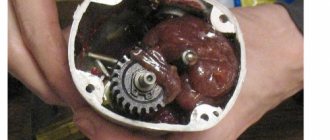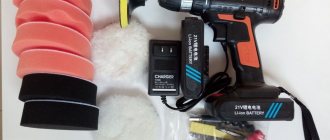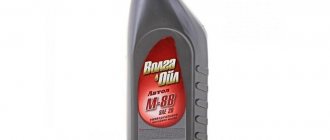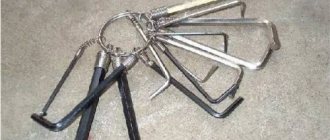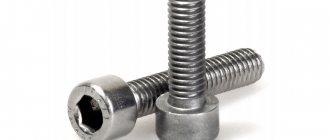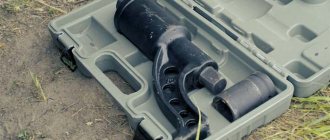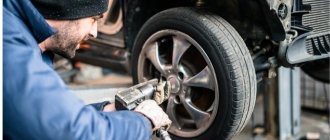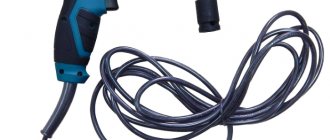March 09, 2020
When repairing or working in a workshop, many different tools are required. There are universal ones that can solve most problems, and there are those aimed at narrow applications. A striking example is a screwdriver and impact wrench. Although they operate similarly, these tools have differences that make them useful in different situations. Later in the article we will look at the difference between a wrench and a screwdriver, as well as in what cases one or another tool will be needed.
What is a screwdriver
A screwdriver is a hand-held electric tool in the shape of a gun, which in some cases effectively replaces a classic drill. Purpose – screwing in self-tapping screws, screws, screws. Along with rotary hammers, this is a useful metalworking equipment in production and at home. The tools will be useful when replacing car upholstery, installing curtain rods, brackets for household appliances, and shelves. They are convenient for assembling furniture and are indispensable when installing windows and doors. Unlike a drill, a screwdriver comes with many attachments. Including for tightening nuts.
A tool with a battery is mobile in use
This is a device in a housing consisting of an electrical “filling” - a motor with reverse to change the direction of rotation and mechanical control parts:
- single-speed or multi-speed gearbox;
- a spindle with a quick-release chuck for replacing accessories (models with a hexagonal socket holder are also available);
- torque coupling - to regulate the speed of rotation of the nozzles.
Some models are equipped with a backlight.
The tool is powered by a power cord or, in autonomous mode, by a battery. Operation is based on the principle of converting electrical energy into mechanical energy. The power transmission causes the equipment to move.
The best screwdrivers 2020-2021
A screwdriver is a tool that, despite its compactness, impresses with its productivity and speed of operation. A screwdriver is useful where there is a need to firmly tighten self-tapping screws and screw caps of large diameter. The principle of operation of a screwdriver is a tangential impact, which helps the tool screw a screw into a surface, or firmly connect two surfaces to each other. Thus, a screwdriver differs from an impact drill (or hammer drill) in the angular impulse. To create such an impulse, a motor powered by mains power or battery power can be used. The screwdriver is applicable in construction, mechanical engineering, and instrument making. A compact and maneuverable cordless screwdriver is useful in everyday life, since large amounts of work in the house are not required. Below we take a look at this special tool and the 5 best screwdriver models. As an addition, tips for choosing a screwdriver.
How is a screwdriver different from a screwdriver?
The main tasks of both a screwdriver and a screwdriver are screwing in/unscrewing screws, screws, and bolts. Most models transmit torque from the motor to the gearbox, and, accordingly, to the spindle with the equipment (working part) fixed in it.
Differences between a screwdriver and a screwdriver:
- a screwdriver gives an angular impulse to the screw, and a screwdriver gives a direct blow;
- a screwdriver, as a rule, has a more powerful impulse;
- a screwdriver copes with thick and long bolts/capcaillie and self-tapping screws;
- the screwdriver spindle is capable of holding bits, but is not designed to work with drills;
- a screwdriver can withstand more loads than a screwdriver.
Main advantages of the screwdriver:
- efficiency when screwing in long screws;
- high-quality screwing in cap screws with hexagonal or square heads and external threads;
- fast speed of screwing screws into wood (compared to a screwdriver);
- energy savings (for network models).
However, you should know that a screwdriver, although less powerful, is cheaper and more versatile than a screwdriver.
Their common screwdriver disadvantages are worth mentioning:
- noise,
- lack of a clamping torque adjustment clutch (sometimes this powerful tool overtightens and even breaks small screws);
- This tool does not accept drills with a cylindrical shank due to its design;
- A good screwdriver is not cheap.
You should choose a screwdriver depending on your task. Where more reliable fasteners are needed, a screwdriver is more relevant.
How to choose a screwdriver?
Let us highlight the main technical characteristics that should be taken into account when choosing a screwdriver
Tightening torque: in the case of this tool, this is not the torque of the gearbox, but a more powerful force obtained as a result of the tool applying a series of impulses (impacts) to the screw
The tightening torque usually lasts less than 10 seconds and is measured in Nm. When choosing a screwdriver, pay attention to the fact that the motor can be brushed or brushless:
- Brush-type (cheap, proven, runs on direct current, requires brush replacement, sometimes sparks);
- Brushless (more expensive, has built-in permanent magnets, good heat dissipation, has less weight and better ventilation).
If you don't want to save money, choose a compact and modern screwdriver with a brushless motor.
- Voltage: the power of the screwdriver depends on this indicator:
- 10.8 V – a small and lightweight household tool for infrequent use, with a tightening torque of up to 100 Nm;
- 14.4-18 V – medium, more powerful tool, with a tightening torque of 150-160 Nm;
- 36 V – professional screwdriver for assembling structures.
Screw/Bolt Diameter: Please note that a wider screw will require more force to be installed. When choosing a screwdriver, read the instructions to see what range of bolts it covers.
For example, "M6-M16". So, for a battery model, the fastener sizes can be in a narrower range: M16-M20. The battery is an important component of the impact wrench, as it ensures longevity:
- nickel-metal hydride (short-lived, environmentally friendly);
- nickel-cadmium (durable, non-ecological);
- lithium-ion (not prone to self-discharge, unlike the previous two).
- Functional:
- several screwing modes (soft – for self-tapping screws, medium – for bolts and screws of medium size, maximum – for tightening long and thicker screws);
- rocker switch with reverse (choice of screwing in or unscrewing by changing the direction of rotation);
- illumination of the working area (for working in dimly lit places);
- charge indicator (to monitor the time remaining for operation from one battery).
What is a impact wrench
Designed for connecting structural elements with threaded nuts. Powered by mains power or battery charge. The shape is like a pistol, the body with the working units located in it is elongated. Functions like a wrench: the tool works to tighten and unscrew. The operating principle is similar to a screwdriver - based on torque and high rotation speed. Used at car service stations, during construction work, and in the household.
No tire service is complete without a wrench
Impact wrenches operate on mains, battery, pneumatic or hydraulic power. Scrolling of fasteners is carried out by a gearbox. There is a reverse motion. In this case, the rotation speed is the same. The impact wrench comes with a set of impact sockets for nuts, anchors and bolts. Equipped with a switch that changes the direction of rotation and a ratchet that regulates the degree of clamping.
Standard set of impact wrench
Top 3 best models
The construction tools market offers a wide range of similar products. We have selected the 3 most successful models:
Metabo BS 18 LTX. Screwdriver made in Germany. It has a quick-release chuck, powered by an 18 V battery. The maximum torque is 110 Nm, suitable for working with wood and metal. Additional options include spindle lock, built-in overload protection and speed adjustment. There is a hook for wearing on a belt. Sold in a case without battery and charger;
DeWALT DCF887N-XJ. Compact brushless screwdriver from a famous American brand. It is painted in the manufacturer's traditional yellow-black color, which is convenient for searching in a cluttered object. Equipped with an internal hexagon chuck. There is a pulse mode and the possibility of shock operation. The brushless electric motor operates from an 18 V battery, the maximum speed is 3250 rpm. The minimum configuration does not include a case or an additional battery;
Makita DTP141Z. Professional instrument with impact and pulse modes of operation. Maximum torque – 150 Nm. Suitable for working with wood, metal, and effectively unscrews rusted nuts. Equipped with a brushless electric motor and an 18 V battery. Battery and charger are not included. Chuck with hex mount. It is possible to turn on the backlight, the handle is rubberized and fits comfortably in the hand. Supplied in a box, tool weight – 1 kg.
When purchasing a tool for household or professional tasks, you should pay attention to the cartridge. The choice of nozzles according to the type of shank depends on this
As a rule, high-power impulse models are equipped with a hex chuck only.
Important! The specific cost depends on the pricing policy of the store, as well as the configuration of the product. In large chain stores you can additionally purchase a storage case, a charger and a second battery
Main differences
A screwdriver is a tool for installing a variety of fasteners. If you equip it with an adapter and a socket head, it can be used as a wrench. A screwdriver can only be used for small jobs. Impact wrenches are professional tools. The devices differ from each other as follows:
- Power. Screwdrivers are less powerful than impact wrenches. There are models of impact wrenches that are equipped with a gasoline engine and are used in the railway industry.
- Mass. Screwdrivers weigh less than screwdrivers. The weight of the “domestic” does not exceed a couple of kilograms. Pneumatic or hydraulic impact wrenches, common in industrial production, weigh many times more.
- Dimensions. Professional impact wrenches are up to 60 cm long, screwdrivers are about 20 cm long.
- Patron. Impact wrenches generally do not have them. The design does not provide for equipping with a cartridge. Instead, the tool is equipped with a rod that has a special mount for socket nut heads;
- Functionality. The screwdriver is designed for installing various types of fasteners: bits with straight and cross slots, disc shears, attachments for restoring chamfers of bolts, polishing, and cutting metal. It is used mainly in construction work - when screwing or drilling low-density materials. With an adapter it can be used for tightening nuts or as a regular drill. The impact wrench does not please with its multifunctionality. It is intended only for unscrewing and tightening nuts with rods of different diameters.
Adapters. The clamp at the top securely holds the heads under the nuts
- Impact mechanism. The impact wrench is not intended for drilling holes; its impact block serves to gradually loosen a stuck bolt and has a different operating principle than a screwdriver. The latter has a direct blow to the bit, while the impact wrench has an angular impulse.
- Resistant to loads. The impact wrench is wear-resistant because equipped with a more powerful motor. The competitor is not designed for heavy work.
- Nozzles A screwdriver works with bits and drills; only heads are suitable for a wrench.
Set of bits for a screwdriver
- Cost. The difference is not in favor of the impact wrenches.
Visually the tools are very similar
Manufacturers
Despite the fact that such a tool appeared not so long ago, its selection is quite large. Particularly popular are models created in Japan, America, Russia and Germany, among which several of the most famous are worth noting.
- Bosch. A striking example is the GDR 10 model. It features a brushed motor, has a battery, backlight, and a brake for the motor. In addition, the kit includes a second battery. This model is quite powerful, lightweight and also compact, but has an uncomfortable handle.
- Hilti. The SIW model, which has three speeds and can regulate not only the frequency, but also the direction of rotation, is very popular. It is complemented by backlighting and has an additional battery.
This impact wrench is easy to use and does not take up much space. Its only drawback is the high price.
- A.E.G. This German brand has become offering premium products. The BSS 18C 12Z-0 model runs on a battery, and may shut down if the load is too heavy. The kit includes a backlight and a spare charger. This device is easy to use, quite powerful and has an average price.
- "Bison". The Russian company enjoys well-deserved fame. The impact wrench "ZGUE-350" is frost-resistant and has a metal body. In addition, it features automatic speed control, is easy to use, and has an average price. The company provides a warranty period of up to 5 years.
- DeWALT. This is one of the leaders in the modern market. The DW 292 model is more professional. It has a shockproof body, a rubberized handle that helps reduce vibration, and a locking device. In addition, the DW 292 is a fairly powerful model that is durable.
Which one is better to choose?
The answer to the question depends on what types of work need to be performed. For example, you cannot tighten screws with a wrench. Due to the so-called tangential impact, he will simply tear off their caps. In the absence of a stop, the screwdriver is able to create a fastening that even a powerful screwdriver cannot duplicate. If there is a small amount of work to be done, including only screwing in screws, then a regular screwdriver will be enough for this. Therefore, the choice of tools is determined by the specifics of the work.
Carrying out installation work
The first piles are screwed into the corners of the foundation. After marking the land plot for development, places for their installation are determined.
Small holes are first dug by immersing the tip, which has a helical blade, into the ground. The tightening of screw piles begins with the products located at the corners of the foundation. Then all the others are aligned in height.
If it is impossible to level them horizontally during installation due to the fact that some can no longer be screwed into the ground, they are cut to the required height. Please keep in mind:
- installation must be carried out strictly vertically. To do this, it is necessary to periodically check the installation process using a magnetic or water level;
- You cannot screw another one in place of the one that has been unscrewed.
How to make a wrench from a screwdriver
A screwdriver can be converted into a screwdriver. This “conversion” will be useful for car owners who want to save time on seasonal tire changes and in many other cases. Having a screwdriver in your set of household tools, you can solve a number of problems, including tightening and unscrewing any nuts. In order not to tinker with the nuts manually, you need to stock up on a special adapter for socket heads for nuts of different diameters.
To turn a screwdriver into a wrench, you just need to hold the end of the adapter with a chuck and install a suitable attachment. The device is ready for use. It won't take long to transform into a screwdriver. There is no need to buy additional tools. A standard set of 9-12 nozzles of different diameters will allow you to work with nuts of the most common sizes.
The only inconvenience is that the power of screwdrivers is relatively small. Therefore, the nut can only be twisted, and the fasteners will have to be tightened and loosened manually. But a lot of time will be saved, which is spent more on unwinding the fasteners than on loosening/tightening them.
Metabo and other screwdriver manufacturers have provided the ability to use the tool as a full-fledged screwdriver with drilling function. There is a drill bit for this. It is quickly installed on the instrument. Therefore, turning a wrench into a screwdriver is no less realistic than the reverse process.
Impact wrench adapter allowing the use of bits
Of course, you can delve into the electronics of the device to increase the rotation speed of the working elements. However, it is better not to do this, so as not to break the tool and not lose the factory warranty. Manufacturers indicate the main parameters of products in the operating instructions in the technical specifications section. Such manipulations may be hazardous to health.
A screwdriver and impact wrench are useful tools in production and at home. When using special attachments and adapters, their functionality expands.
Drilling tool
The best invention for manually making holes in walls is a hammer drill. This is not a cheap device, so it is not available in every home. A “lightweight” option for drilling walls is an impact drill. It is more accessible than a hammer drill, but its capabilities are not as impressive. You need to drill at low speed first, gradually increasing it.
Keep in mind that brickwork is well resistant to constant pressure, but it begins to crumble from impacts. Drilling with a regular drill will be very slow because the drill will have difficulty gripping the hard brick. The drill will become very hot.
In order not to be disappointed in the purchased impact drill, pay attention to its minimum characteristics:
- The power should not be less than 600 W.
- Rotation speed up to 2500 rpm.
- Gradual adjustment of rotation speed.
- Reverse. Needed to rotate the drill in both directions.
- Keyless chuck. Allows you to change drills without a special key, which is always not at hand.
- The presence of shock mode. The drill will not reach the hammer drill, but it will help you achieve the desired goal faster.
- Any tool has instructions. You need to read it and follow the recommendations provided. Otherwise, unpleasant consequences may occur in the form of breakdowns or injuries.
Additional options and convenience
And the last thing people pay attention to when deciding which screwdriver to choose is ease of use. It’s definitely worth paying attention to how comfortable the instrument “fits” in your hand. You often have to work for several hours at a time, and if your hand gets tired quickly, it becomes torture. For greater comfort, rubber pads are placed on the handle. They significantly increase the comfort of use. There are other options that make your work easier.
Availability of reverse
Almost all modern screwdrivers have reverse motion or reverse. It allows you to quickly unscrew a screw or pull out a drill stuck in the material. Reverse motion is activated using a special button, which is located near the trigger.
To prevent the tool from immediately changing direction (accidental pressing of the reverse button is possible), many models, for safety reasons, have an intermediate mode. After switching, the shaft stops, and only then does it start in the opposite direction.
Mains power or batteries
There are two types of screwdrivers - mains-powered and battery-powered. Both options have advantages and disadvantages. The advantage of a corded screwdriver is that it works as long as there is voltage in the network. The second positive point is that it is cheaper than similar battery-powered tools. But the biggest advantage of corded screwdrivers is that they can remain idle for as long as desired without compromising performance. Cordless tools require regular “training” during periods of long periods of inactivity. Batteries must be discharged and recharged periodically. Otherwise, they may not “wake up.”
There are also disadvantages - the power cord limits freedom of movement and sometimes gets in the way quite a bit. The second drawback is that 220 volts are not available everywhere, and on construction sites this is generally rare. The question of how to choose a screwdriver that operates from the mains is practically not worth it. All you need to pay attention to is the length of the power cord. The longer it is, the more convenient it is - there is no need to use a carrier. The rest of the choice lies in the selection of technical parameters.
Cordless screwdrivers also have their pros and cons. Plus - greater mobility and independence from power supply. The downside is a higher price, more weight and the need to recharge the batteries. That is, dependence on power supply still exists, but not so severely.
If desired, you can have a second set of batteries (many companies immediately equip their tools with two batteries). This will ensure virtually uninterrupted operation. Despite the inconvenience of charging and extra weight, most people decide to purchase a cordless screwdriver. And when they talk about how to choose a screwdriver, they mean a battery-powered tool. If you come to this opinion, you need to understand the types of power elements.
Test results
Metal particles crumbled from the impact surfaces of the coupling stick to the electric motor and can damage it.
Metal particles crumbled from the impact surfaces of the coupling stick to the electric motor and can damage it.
The cheapest impact wrench (Bort BSR‑12) did not survive to the end of the tests - the plastic gear turned. The most expensive one, Makita TW140DWAE, turned out to be very weak: its efforts were not even enough to unscrew the wheel fasteners. “Zubr” delivered a torque about half of what was promised: for most cars this should be enough. The same can be said about Bort BSR‑12X.
When choosing a non-professional impact wrench, we recommend focusing on the torque it develops. Even if the impact wrench produces only half of the declared 350 Nm, in practice this will be enough to repair any passenger car. If you bought an externally powered impact wrench, we strongly recommend connecting it not to a standard 12-volt outlet, but through an adapter directly to the battery terminals. Otherwise, you will go broke replacing fuses.
Budget impact wrenches cannot accurately regulate torque
When unscrewing, this is not so important, but when wrapping, you need to get used to it so as not to overtighten the fasteners. In any case, it is advisable to control the final tightening with a torque wrench
After several minutes of testing, the cams of both budget impact wrenches were damaged: there was metal chipping.
After several minutes of testing, the cams of both budget impact wrenches were damaged: there was metal chipping.
Impact theoryWhere does a sledgehammer weighing one kilogram get the opportunity to press in a bushing or bearing when a force of up to a couple of tons is required? It's simple: even a small mass that has received a huge negative acceleration (instantaneously stopped) allows you to create a very significant force. All impact wrenches work on the same principle. Devices with a total weight of no more than a couple of kilograms, equipped with a motor, the same as in small-sized tire compressors, and a fly clutch no heavier than 0.6 kg, allow you to develop a torque of 350 N.m. But by putting a heavy head on the output shaft of the impact wrench, we lose the torque applied to the fastener - here the mass will work against us. And if you use extensions and adapters, then almost the entire power of the impact will get stuck in the parasitic mass and gaps. |
Screwdriver for home and work. My tips for choosing (voltage, power, etc.)
A screwdriver is a tool with which it is very convenient to twist self-tapping screws; its main purpose is precisely this. However, this is not the only limit to the functionality of this useful tool, you can also drill wood, metal and even brick (if the impact function is present).
Of course, it is not at all necessary to have a screwdriver in the house when you have a drill, however, if you often work with self-tapping screws, then a “shurik” is simply necessary.
Screwdrivers are divided into 2 main types - cordless and corded. (You can read about corded screwdrivers for the home here.) Of course, the vast majority buy cordless ones, since they can be used where there is no electricity. For example, at the dacha, when the wires have not yet been installed. So, whatever one may say, a cordless screwdriver is a necessary and very useful tool
So, how to choose this tool, what to look for, what features to look for and what brands to look for? Answers in this article
How many volts should I use?
If you went to tool stores, you saw that screwdrivers come in 9.6 volts, 12 volts, as well as 14.4, 18 and even 24 volts. What do all these numbers mean and how do they affect your work? The voltage supplied to the battery determines the power of the tool.
Simply put, the higher the voltage, the higher the power. In turn, the higher the power, the slower the battery discharges. Since we are choosing a tool for the home, we should not take the most powerful one, because it will be heavy. Why do we need a heavy tool if we plan to use it only when tightening screws?
For home use, 12 volts is quite enough, but I think 14.4 is the most optimal. The difference in price between the 12 and 14.4 volt Shurik is insignificant, so it’s better to overpay a little and buy a more powerful one. However, there is also no big difference in torque; 14.4 will be 20 percent more powerful. Therefore, first of all, figure out what kind of work you will be doing and, based on this, select a model of a certain voltage.
Tightening torque - how many newtons?
By and large, this is the most basic parameter of the “Shurik”. Measures the tightening torque in Nm (newton per meter). If you estimate this way, then most home models have a torque of no more than 18 Nm. How much force is needed to tighten screws? The question is certainly interesting.
Driving thick screws requires much more force than thin screws. Let's take, for example, a self-tapping screw with a thickness of 3.5 mm (standard for wood) and a roofing screw with a thickness of 6.3 mm. The difference in thickness is significant. We will also take into account the length of the screw; you must agree, it’s one thing to screw in 30 mm or 100 mm.
To tighten standard black wood screws, a small tightening torque is sufficient; as a rule, all household 12-volt screwdrivers have a torque of 10-15 Nm. This torque is enough to tighten a self-tapping screw on wood up to 150 mm long.
However, it is a completely different matter if you are going to cover the roof of your dacha using roofing screws. They are usually very thick (4.8 and 6.3 mm thick), so the tightening force must be much stronger.
As you already understand, 15 Nm is not enough here, so choose models with a more powerful tightening torque, usually from 20 Nm. And here when choosing, confusion begins, it seems that the screwdriver is powerful, 18 volts, but the torque is weak. Or vice versa, a 12 volt screwdriver has a torque of 28 Nm. How does this happen? Let's figure it out.
Although there is nothing to understand here, logically, the higher the voltage, the greater the torque. However, this is not the case with professional models; all 12-volt models have a solid torque of 24 Nm and above. For household ones, in order to achieve a tightening torque of at least 20 Nm, the screwdriver will have a higher power supply, most often from 18-24 volts.
How many batteries are included?
Also, various models have 1 or 2 batteries included. When purchasing a screwdriver, consider whether you will need a second battery. As a rule, it comes in handy when there is a lot of work to be done. While you are working with one, the second one is charging. If the first battery is discharged, you insert the second one and continue working without interruption, and immediately put the discharged one on charge.
And if you work for 20-30 minutes a day, then one battery will be enough and you won’t have to overpay.
A model with 2 batteries costs 20-30 percent more. It is worth saying that the most expensive thing in a tool is the battery; it takes up 80 percent of the cost of the entire tool. For example, a 14.4 volt battery for the Black and Dekker model costs about 1800 rubles, while the “Shurik” itself with 1 battery costs 2400.
Operating principle
All purchased impact wrenches are of the impact type. But the principle of operation is different. Both Bort impact wrenches do not have a soft start. The output shaft begins to rotate only when the massive coupling unwinds and centrifugal forces move the loads into position. They engage the output shaft cam and transmit torque to it. Such a rough application of a large moment at once, and even with an impact, determines the scope of use of these impact wrenches: fastening wheels, as well as unscrewing bolts and nuts of the chassis tightened with a large torque.
The Zubr and Makita cordless impact wrenches have a different principle. Their output shaft begins to rotate immediately. Essentially, at first they work like regular screwdrivers. As the resistance increases, the impact clutch is activated. Such a smooth start allows you to use these impact wrenches when disassembling and assembling most components and assemblies of a car.
| Price ~5200 ₽Cartridge square ½“ The battery-powered “Bison” with a planetary gearbox and smooth starting tightened the bolt so that it required a torque of 200 Nm to loosen it. It seems that this is his real limit: when trying to unscrew the fastener, he could only cope with the bolt that had been previously tightened with a torque wrench to a torque of 200 Nm. Higher levels were beyond our reach. Note the presence of an LED battery charge indicator. |
| Price ~2000 ₽Cartridge square ½“ The speed cannot be adjusted. The peak current consumption reaches 22 A: a car socket is unlikely to withstand it. The fasteners tightened with a power tool were unscrewed with a torque wrench at a torque of 300 Nm. The reverse operation also went well: the power tool was able to unscrew a bolt tightened with a torque of 350 Nm. But that’s where the positives ended: the clutch drive turned on the plastic gear. The design turned out to be clearly weak. But the wear of the mechanism, on the contrary, is strong. The indicated operating time is 40 hours, but our copy “died” much earlier. |
| Price ~3400 ₽Cartridge square ½“ The maximum peak current is up to 21 A: a standard 12-volt outlet may not withstand it. The bolt, tightened with all the force with this wrench, was unscrewed at a torque of 200 Nm. The reverse test turned out to be more optimistic: the power tool was able to unscrew the fastener, previously tightened with a torque of 300 Nm. But 350 Nm did not submit to him. There is no flimsy plastic gear, like that of the broken namesake: the moment is transmitted by a steel shaft. The instructions indicate that the tool should operate for approximately 40 hours. This means that they can change the wheels on their car for up to ten years. |
| Price ~7900 ₽Cartridge square ³⁄8“ |
Chuck type
There are two types of screwdrivers: keyed and quick-release chucks. The second option is more convenient, since the bits are released and clamped by turning the chuck, without additional devices. In this case, the tool is held with the left hand and the chuck is rotated with the right. Keyless chucks come in two types - with one or two couplings. The second coupling serves to lock the shaft so that the nozzle can be changed. If there is only one clutch, there is a button on the housing to lock the shaft, with which the shaft is locked. In this case, before starting to replace the nozzle, press the shaft lock button, hold it, and replace it. Release the button, you can work.
There are two types of quick-release chucks - single-clutch and double-clutch
An additional advantage of the quick-release chuck is that you can install a nozzle with a shank of any diameter into it. The main thing is that it fits into the holder. Therefore, when choosing a screwdriver, we pay attention to such a parameter as the diameter of the chuck. It determines the maximum diameter of the nozzle that can be installed.
Key cartridges require a special key. It is inserted into the hole in the chuck, turning in one direction or the other, and the bit or drill is released or clamped. This tool costs a little less, since its design is a little simpler.
